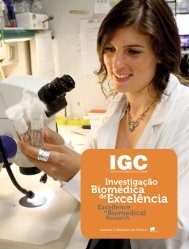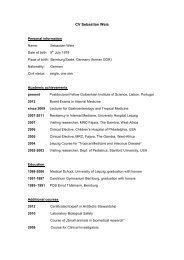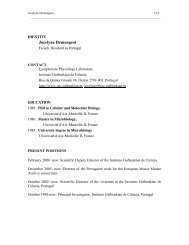organisation - the Instituto Gulbenkian de Ciência
organisation - the Instituto Gulbenkian de Ciência
organisation - the Instituto Gulbenkian de Ciência
- No tags were found...
Create successful ePaper yourself
Turn your PDF publications into a flip-book with our unique Google optimized e-Paper software.
BEHAVIOUR<br />
AND METABOLISM<br />
THIS GROUP IS A MEMBER OF THE CHAMPALIMAUD NEUROSCIENCE PROGRAMME AT THE IGC<br />
Carlos Ribeiro Principal Investigator<br />
PhD in Cell Biology, University of Basel, Basel, Switzerland, 2003<br />
Postdoctoral fellow, Biozentrum, University of Basel, Switzerland<br />
Postdoctoral fellow, Research Institute of Molecular Pathology (IMP)<br />
and Institute of Molecular Biotechnology (IMBA) of <strong>the</strong> Austrian Aca<strong>de</strong>my of Sciences, Vienna, Austria<br />
Principal Investigator at <strong>the</strong> IGC since 2009<br />
link to external website<br />
We are interested in un<strong>de</strong>rstanding how molecular and cellular mechanisms control<br />
complex biological processes at <strong>the</strong> level of <strong>the</strong> whole organism. For this<br />
we are focusing on how <strong>the</strong> internal metabolic state of <strong>the</strong> fruit fly Drosophila<br />
melanogaster affects its behavioural <strong>de</strong>cisions. Starting from novel behavioural<br />
paradigms we use molecular genetic techniques to i<strong>de</strong>ntify and characterise<br />
genes and neuronal populations involved in producing <strong>the</strong> appropriate behavioural<br />
response to a specific metabolic need of <strong>the</strong> fly.<br />
MOLECULAR MECHANISMS OF NUTRIENT CHOICE<br />
We want to un<strong>de</strong>rstand how Drosophila knows what type of nutrients it needs<br />
and which are <strong>the</strong> molecular mechanisms used by <strong>the</strong> nervous system to change<br />
<strong>the</strong> behaviour of <strong>the</strong> animal to allow it to find and eat <strong>the</strong> required nutrients.<br />
We have continued investigating how conserved nutrient sensing pathways act<br />
in <strong>the</strong> nervous system to control feeding. Fur<strong>the</strong>rmore, by analysing genes i<strong>de</strong>ntified<br />
as being required for nutrient choice in a neuronal whole-genome RNAi<br />
screen we are investigating novel molecular mechanisms mediating nutrient homeostasis.<br />
Taken toge<strong>the</strong>r <strong>the</strong>se studies are providing us with a mo<strong>de</strong>l and an<br />
entry point for studying nutrient balancing and value-based <strong>de</strong>cision-making at<br />
<strong>the</strong> molecular level.<br />
GROUP MEMBERS<br />
Laura Napal Belmonte (Post-doc)<br />
Pavel Itskov (Post-doc, started in March)<br />
Ricardo Gonçalves (Post-doc, started in July)<br />
Samantha Herbert (PhD Stu<strong>de</strong>nt)<br />
Veronica Corrales (PhD Stu<strong>de</strong>nt, started in October)<br />
Ana Paula Elias (Lab Manager and Research Assistant)<br />
Célia Mo<strong>de</strong>sto Baltazar (Research assistant)<br />
COLLABORATORS<br />
Aldo Faisal (Imperial College London, UK)<br />
Mat<strong>the</strong>w Piper (UCL, London, UK)<br />
Mattias Allenius (Linköping University, Swe<strong>de</strong>n)<br />
FUNDING<br />
Champalimaud Foundation (CF), Portugal<br />
BIAL Foundation, Portugal<br />
NEURONAL MECHANISMS OF NUTRIENT CHOICE<br />
We want to i<strong>de</strong>ntify and analyse <strong>the</strong> neuronal networks used by Drosophila<br />
to change <strong>the</strong> behaviour of <strong>the</strong> animal to allow it to find and eat <strong>the</strong> required<br />
nutrients.<br />
We have used genetic approaches to i<strong>de</strong>ntify neuronal populations which are<br />
required for nutrient choices. Currently we are analysing <strong>the</strong> i<strong>de</strong>ntified neuronal<br />
substrates for nutrient homeostasis to un<strong>de</strong>rstand how <strong>the</strong>se neuronal populations<br />
act to gui<strong>de</strong> feeding <strong>de</strong>cisions.<br />
What type of food should <strong>the</strong> animal choose?<br />
QUANTITATIVE ANALYSIS OF FEEDING BEHAVIOUR IN DROSOPHILA<br />
In collaboration with <strong>the</strong> laboratory of Aldo Faisal at Imperial College London<br />
we use automated vi<strong>de</strong>o analysis to quantitatively link genetics to feeding<br />
behaviour in <strong>the</strong> fruit fly. These studies are providing us insights into <strong>the</strong> behavioural<br />
strategies used by <strong>the</strong> fly to maintain nutrient homeostasis as well as<br />
<strong>the</strong>ir biological implementation in <strong>the</strong> nervous system.<br />
Drosophila adult brain (gold) with specific neuronal subsets marked by GFP (green).<br />
Automatically tracked path of a foraging fly.<br />
IGC ANNUAL REPORT ‘11<br />
RESEARCH GROUPS<br />
58






